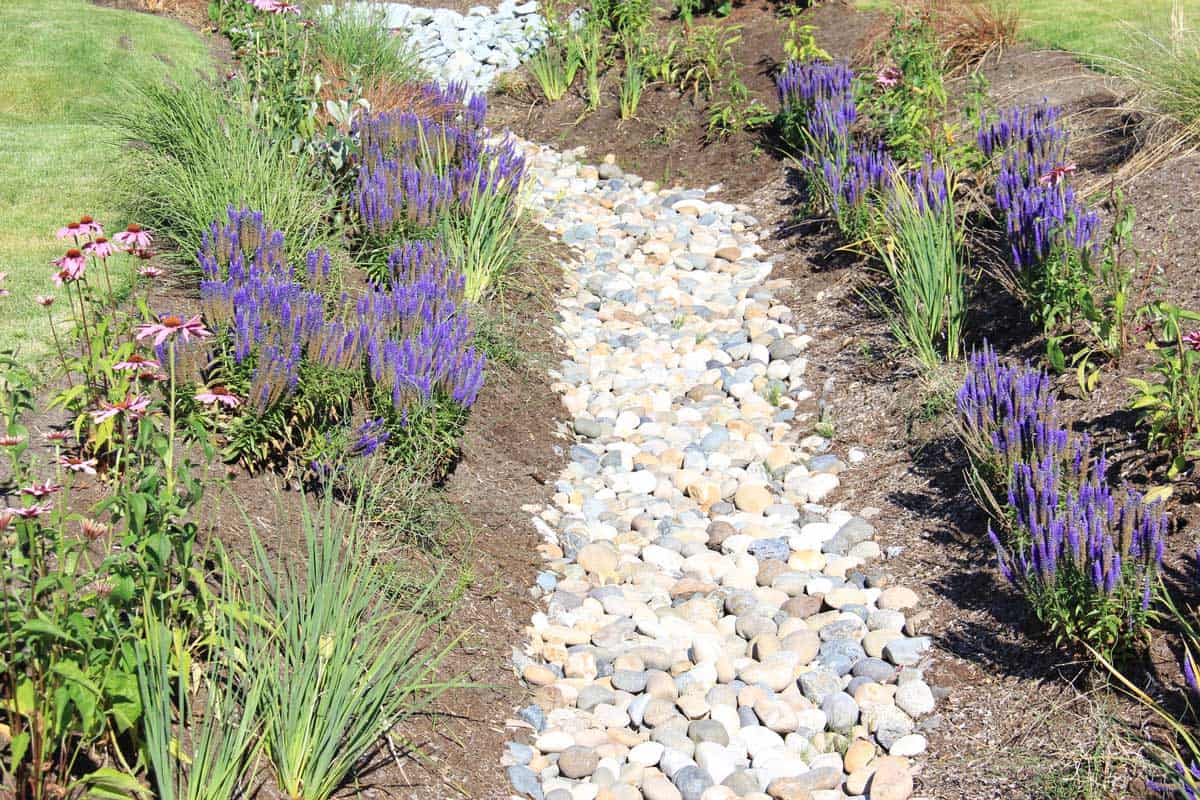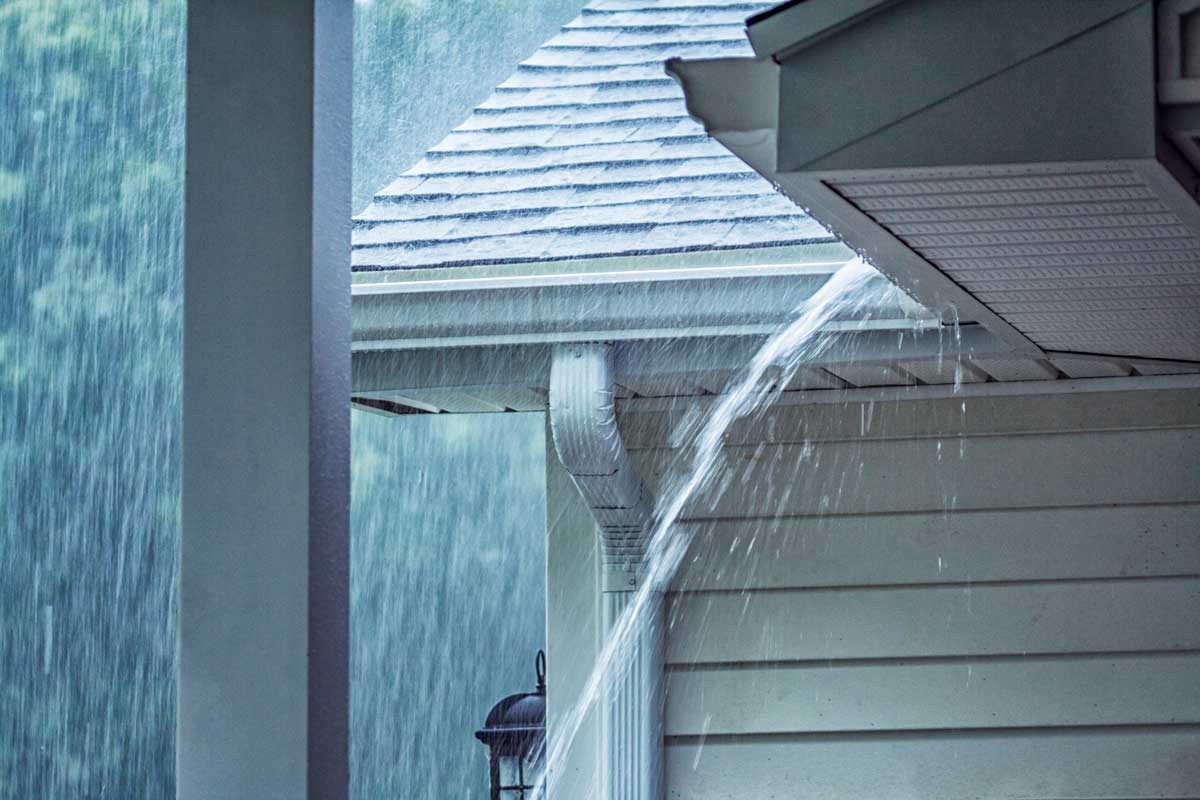Gutter overshoot occurs when rain flows over, instead of into, the gutters. Proper water diversion into the gutter is needed to avoid foundation and siding damage, mold and mildew growth, premature roof wear, basement flooding, and landscape erosion. We looked into home builder, roofer, government, and higher education guidelines to determine potential issues and solutions to help you prevent your gutters from overshooting.
Stop the rain from overshooting the gutter by taking steps to improve the overall gutter, drain, and roof edge setup. Verify basic gutter system setup and maintenance by looking for typical issues, such as:
- The shingles overhang at roof eaves.
- The roof valley overflows.
- Gutters are improperly installed.
- Gutters are too small.
- Additional downspouts or rain chains are needed.
- Ground diversion is needed.
- The gutter system needs maintenance.
- Gutters need cleaning.
Gutter overshooting is an issue that demands prompt attention to facilitate home and occupant well-being. Let’s examine some troubleshooting considerations and ideas for resolving this issue.

What happens when gutter overshooting occurs?
Gutter overshooting occurs when rain or melted snow pours past gutters. While rain overshooting the gutter may cause annoyance by spraying over onto guests, homeowners, and pets, long-term gutter overshooting issues may cause moisture damage to the home. Mold and mildew growth from moisture issues may cause home damage and breathing issues for the home occupants.
Why do my gutters overflow in heavy rain?
Heavy rain increases water power and speed as it moves quickly down the roof and shoots over gutters. Steep roofs and the associated valleys accelerate water flow. Too much shingle overhang at the roof edges, the roof design, or gutter configuration may contribute to gutter overshoot issues. Proper downspout installation and water diversion are required to facilitate gutter drainage.
Inspect Gutters Regularly
To facilitate gutter inspection, maintenance, and upgrades, use a sturdy properly-sized ladder. Use your actual home measurements to determine ladder size. A ladder resting against a home should extend 3-feet above the roofline. Include the lean angle when determining ladder size. The 4:1 ladder formula facilitates calculation; for every 4-feet of home height, the ladder should be 1-foot away from the home.
Check the out Little Giant Multi-Position Ladder at Amazon.
Shingle overhang at roof eaves
Shingles that extend past the roof edge may direct water as overshoot or may bend and break off into the gutter. Verify roof drip edge supports the shingles that extend past the roof edge. Trim shingles to ½-inch or less past the edge flashing.
Check out Dewalt Metal Shears Attachment at Amazon.
Roof Valley Overflow
Roof valleys, especially paired with gutters that are too small, will cause gutter overshoot. Try gutter gusher guards to direct water into the gutter against the heavy water force of the valley.
How to install gutter gusher guards?
Gutter gusher (or splash) guards help direct rain from a roof valley to prevent overshoot. These inexpensive, easy-to-install guards deflect the waterfall effect into the gutters. Gutter gusher guards are often paintable or available in multiple color options.
Attach gutter gusher guards to the gutter's outer lip at the end of the roof valley edge. Purchased gutter splash guards typically attach with the connection area facing away from the roof.
Check out Eagle 1 Gutter Splash Guards at Amazon.
Drill holes through the gusher guard lip and gutter. For additional sealing, apply silicone caulk on the guard lip edge before connecting to the gutter. Use a cordless drill to speed up the installation process.
Check out Dewalt Cordless Drill Driver at Amazon.
Proper Gutter Installation
Proper gutter installation helps prevent overshoot. Gutters should be located to collect water flow. Correct the setup to better manage roof water volume rather than having gutter channels back up with water and cause overshoot.
Roof pitch (angle) helps determine gutter placement. Gutters should be placed in the eaves to catch roof water runoff. Steep roofs have a higher pitch than flatter low-pitch roofs. Steeper roofs allow water and roof debris to flow at a quicker pace and may require larger gutters.
Gutter pitch should be toward downspouts. Pitch too low will cause water to pool instead of going toward the drain option. Pitch too steep will cause overspill with water being pushed too rapidly out of the gutter.
Correct spacing between your home and the gutters provides stability. Without proper location, water weight and snow or ice will push gutters away from the roof and lead to leaks.
Proper gutter height is important for correct water channeling. If the height is too low, water will overshoot the gutter channel.
Gutter size
The gutter size directly affects the ability of the gutter system to channel roof water properly. When gutters are too small for the roof design, they cannot manage water amount and force. Rain or melting snow will then overshoot the gutter. The resolution is often gutter replacement.
Standard shingle roofs with minimal overhang typically work with 5-inch gutters. Metal or other roofs with overhang designs may require 6-inch or larger gutters. Consider roof design specifications and area rainfall averages when determining gutter size. To simplify calculations, use an online tool like the Downspout & Gutter Sizing Calculator from Sheet Metal and Air Conditioning National Association (SMACNA).
Downspouts and Rain Chains
Downspouts and rain chains allow redirection of water away from the home to a collection barrel or drain system. Gutter systems should include proper downspout or rain chain quantity and placement. If downspouts easily clog, consider installing larger ones.
Downspout and rain chain installations are often placed 20 to 50-feet apart. Higher area rainfall and gutter design may dictate the need for more drain options.
What about rain chains?
Rain chains take the place of downspouts. The Clemson Cooperative Extension Rain Chain fact sheet highlights the rain chain process as one that utilizes surface tension and provides a ‘path of least resistance’ to the ground.
While rain chains come in stylish chain-link configurations, ornate designs may better complement the home architecture, garden features, and gutter composition. Designs that catch and slow water flow produce less splatter than chain configurations. Some rain chains come as a kit with adapters and installation stakes.
Check out the Sunflower Home and Garden Umbrella Rain Chain at Amazon.
Ground Diversion
To move water away from downspouts, try a landscape drain option. Drainage systems may consist of a simple above-ground flexible drain, an underground drain, or a french drain.
Check out Corrugated Flexible Landscape Drain Pipe at Amazon.
Underground Downspout Converter
To direct water further away from the home, consider a buried drain system. The process basically involves digging a trench, laying and connecting the drain pipes and components, then covering the drain system with soil. Check local regulations to see if specifications exist for the pipe depth.
The World Population Review Frost Lines by State guide provides the depth soil groundwater may freeze in a specific area. A one-foot-deep trench is good if freezing is not a concern. For colder climates, use a 3.5 to 4-foot trench with a well or other draining system.
If you are not up to a self-dug trench project, hire a backhoe operator or rent a trenching machine. If you want to manually dig the trench, use a pickaxe to loosen the soil and break up gravel.
Check out the Fiskars Pick at Amazon.
Use a trench shovel to define trench edges and scoop the upper levels of soil.
Check out the Corona Trench Shovel at Amazon.
As you get deeper into the trench, a hoe will allow you to scoop and transfer soil and rocks more easily.
Check out the Ashman Garden Hoe at Amazon.
French Drain
Another ground diversion option is the french drain. A french drain is a trench filled with gravel and perforated pipe.

For best results, line the trench with a landscaping weed barrier.
Check out ECOgardener Premium Weed Barrier at Amazon.
No-Dig Catch Basin Downspout Extension
If you do not want to dig but still want to divert water further away from the foundation, try a low-profile catch basin, grate, and corrugated drain downspout extension kit. Camouflage with landscape material like mulch or rocks.
Check out the No-Dig Catch Basin Downspout Extension Kit at Amazon.
Do I need a splash block for a downspout?
Downspout splash blocks direct drain water away from the home's foundation. Splash blocks help prevent soil erosion and keep mud-splash stains from the home’s exterior when downspouts drain above the ground. Match the splash block to drain size and verify the splash block channels water away from, rather than holding it in, the drain spout.
Check out the Suncast Downspout Splash Block at Amazon.
Decorative splash blocks may add charm and whimsy to this functional endeavor.
Check out Design Toscano Turtle Splash Block at Amazon.
Gutter System Maintenance
If overshoot occurs with properly-installed correctly-sized gutters, check gutters for repair needs. Replace dented downspouts to allow water to flow freely. Time and water may weigh down and misalign guttering, causing a change in pitch. Routinely check gutters for maintenance needs to ensure the system continues to work properly.
Gutter Cleaning
Gutter channels must be clear to allow proper rain diversion through the gutters. Leaves and other debris clog gutters and restrict water flow. The only water escape outlet remaining is a path over the gutters.
Clean gutters in the fall and spring. Gutter guards help keep gutters clean; periodically verify that the gutter guard top is clear and the gutter channels unobstructed.
Check out the AgiiMan Pressure Washer Gutter Cleaner at Amazon.
Check out the Sun Joe Cordless Pressure Washer at Amazon.
Summary

Gutter overshoot occurs when roof and gutter systems cause water to spill over gutters. Verify shingle overhang, roof valley flow, proper gutter installation and size, downspout and rain chain spacing, ground diversion, maintenance, and cleaning. Proper gutter water diversion is important for home, human, and soil protection.
For additional insight, check out this gutter sizing and cleaning information.















